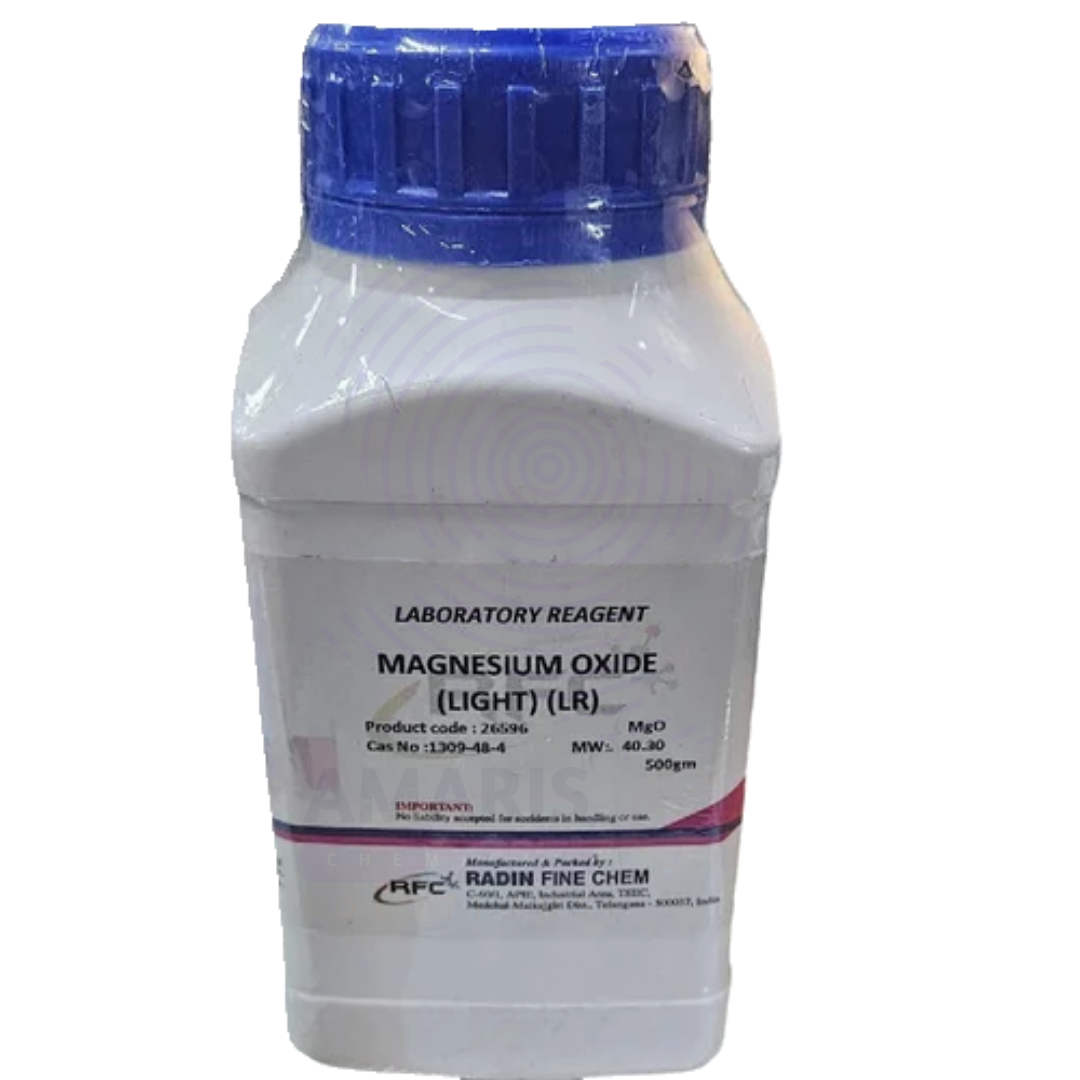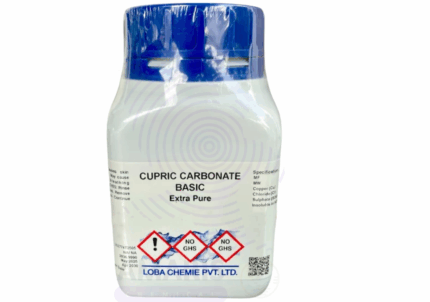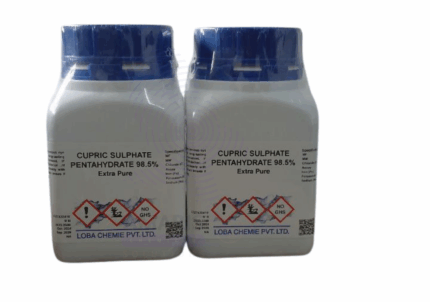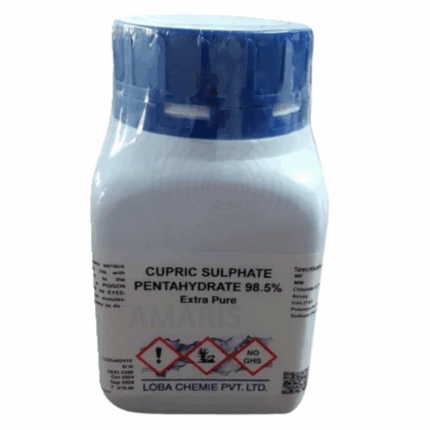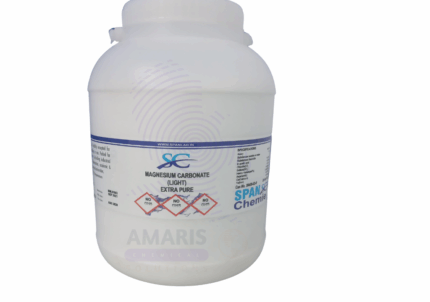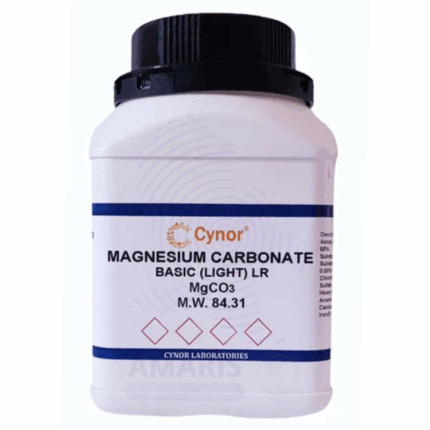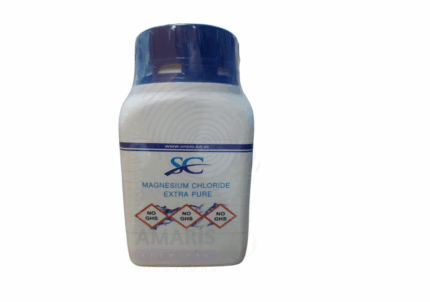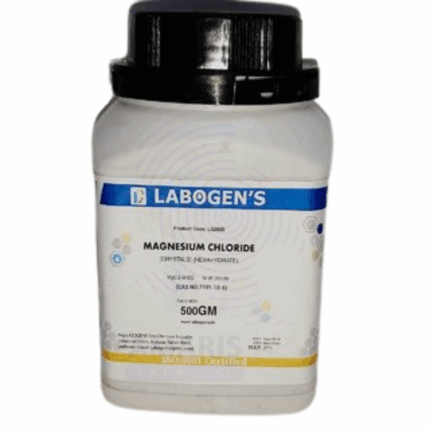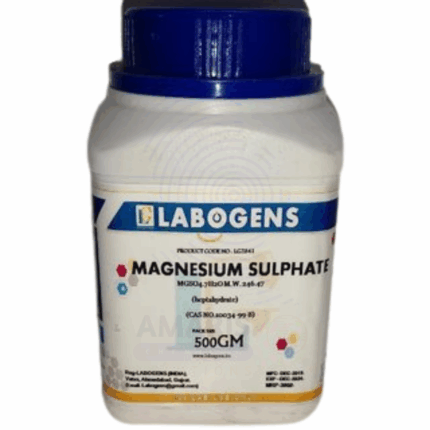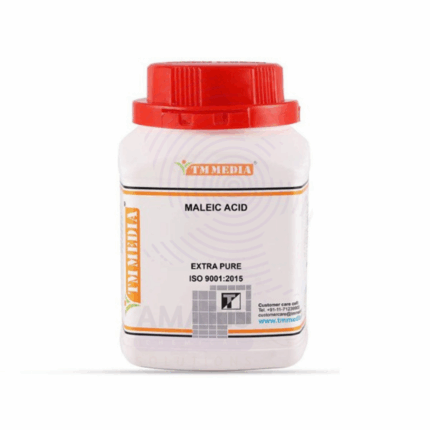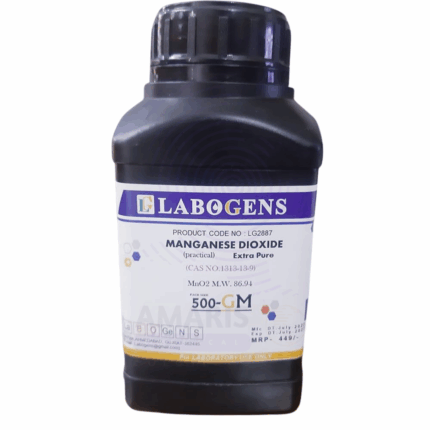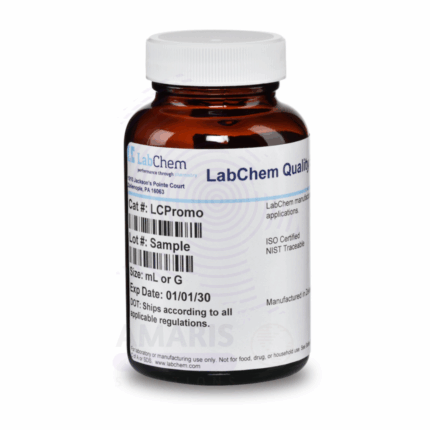
Magnesium Oxide Light Powder Extra Pure
$ 17.00 Original price was: $ 17.00.$ 16.78Current price is: $ 16.78.
Magnesium Oxide Light Powder Extra Pure is a fine, white, odorless powder with a lower bulk density compared to the heavy grade, offering high surface area and excellent reactivity. It is widely used in analytical laboratories, pharmaceuticals, and cosmetics due to its purity and gentle chemical behavior. In pharmaceutical formulations, it acts as an antacid and magnesium supplement, while in cosmetics, it is used for its absorbent and pH-adjusting properties. Its light, fluffy texture also makes it ideal for use in rubber, plastics, and coatings as a filler, stabilizer, or neutralizing agent. The extra pure grade ensures consistent quality for precise and sensitive applications.
Magnesium Oxide Light Powder Extra Pure
Primary Uses
- Acid Neutralization and pH Control:
- Acts as a mild alkali for neutralizing acids in analytical and preparative chemistry.
- Reagent in Inorganic Synthesis:
- Used as a reactant for synthesizing magnesium salts and other magnesium-based compounds.
- Thermal Stability Experiments:
- Suitable for thermal decomposition and high-temperature stability testing due to its refractory properties.
Secondary Uses
- Diluent or Filler in Preparative Formulations:
- Used as a carrier or inert filler in solid formulations and analytical mixtures.
- Standard for Gravimetric Analysis:
- Occasionally employed to generate magnesium-containing precipitates in quantitative analyses.
- Moisture Control Agent:
- Functions as a desiccant or adsorbent in setups requiring dry conditions.
| PACK SIZE |
250 grams Plastic Tin |
|---|
1. Basic Identification Attributes
- Chemical Name: Magnesium Oxide (Light)
- Synonyms: Light magnesia; Calcined magnesia (low bulk density)
- CAS Number: 1309-48-4
- Molecular Formula: MgO
- Molecular Weight: 40.30 g/mol
- Appearance: White, fine, lightweight powder
- Odor: Odorless
- Solubility: Insoluble in water, soluble in dilute acids
- Grade: Extra Pure
- Bulk Density: Approx. 0.2–0.4 g/cm³ (significantly lower than heavy grade)
2. Safety & Hazard Attributes
- GHS Classification:
- Not classified as hazardous under normal laboratory conditions
- Hazard Statements:
- May cause slight irritation to skin, eyes, and respiratory tract due to airborne dust
- Precautionary Statements:
- P261: Avoid breathing dust
- P280: Wear protective gloves, clothing, and eye/face protection
- P305+P351+P338: If in eyes, rinse cautiously with water for several minutes
- Personal Protective Equipment (PPE):
- Dust mask or respirator
- Safety goggles
- Lab coat
- Protective gloves
- First Aid Measures:
- Inhalation: Move to fresh air and seek medical advice if breathing becomes difficult
- Skin Contact: Wash with soap and water
- Eye Contact: Rinse cautiously with water for several minutes
- Ingestion: Rinse mouth; seek medical attention if symptoms persist
- Fire Hazards:
- Non-combustible
- Use extinguishing media suitable for surrounding fire
3. Storage & Handling Attributes
- Storage Conditions:
- Store in a cool, dry, well-ventilated place
- Keep container tightly sealed
- Protect from moisture and acidic substances
- Handling Tips:
- Avoid creating airborne dust
- Use in fume hood or with proper ventilation
- Use dry scoops and containers to prevent clumping
4. Laboratory Applications
- Primary Uses:
- Acid neutralization in analytical chemistry
- Reagent in synthesis involving magnesium salts
- Antacid base in pharmaceutical formulation research
- Secondary Uses:
- Filler in preparation of chemical pastes or slurries
- Component in preparation of ceramic glazes and lab refractories
- Support matrix in catalyst and adsorption studies
SAFETY PRECAUTIONS
Personal Protective Equipment (PPE):
- Wear a lab coat, nitrile gloves, and protective goggles.
- Use a dust mask or operate in a fume hood to avoid inhaling fine powder.
Handling:
- Avoid contact with skin, eyes, and clothing.
- Prevent formation and inhalation of dust.
- Ensure proper ventilation in the working area.
- Wash hands thoroughly after handling.
Storage:
- Store in a cool, dry, and well-ventilated place.
- Keep container tightly closed and protected from moisture.
- Avoid contact with strong acids to prevent hazardous reactions.
FIRST AID MEASURES
Inhalation:
- Move people to fresh air.
- Seek medical attention if respiratory symptoms occur.
Skin Contact:
- Wash skin thoroughly with soap and water.
- Remove and wash contaminated clothing.
- Get medical attention if irritation develops.
Eye Contact:
- Rinse cautiously with water for several minutes.
- Remove contact lenses if present and easy to do.
- Continue rinsing and seek medical advice if irritation persists.
Ingestion:
- Rinse mouth with water.
- Do not induce vomiting.
- Seek medical advice if symptoms appear.
FIRE FIGHTING MEASURES
Flammability:
- Non-flammable in solid form.
Extinguishing Media:
- Use water spray, dry chemical, foam, or CO₂ based on surrounding materials.
Hazardous Combustion Products:
- May release magnesium oxides if involved in a fire.
Firefighter Protection:
- Use self-contained breathing apparatus (SCBA) and full protective gear.


 Preservatives(food)
Preservatives(food) Flavor Enhancers
Flavor Enhancers Acidulants
Acidulants Sweeteners
Sweeteners Antioxidants
Antioxidants Colorants(food)
Colorants(food) Nutraceutical Ingredients (food)
Nutraceutical Ingredients (food) Nutrient Supplements
Nutrient Supplements Emulsifiers
Emulsifiers
 Collectors
Collectors Dust Suppressants
Dust Suppressants Explosives and Blasting Agents
Explosives and Blasting Agents Flocculants and Coagulants
Flocculants and Coagulants Frothers
Frothers Leaching Agents
Leaching Agents pH Modifiers
pH Modifiers Precious Metal Extraction Agents
Precious Metal Extraction Agents
 Antioxidants(plastic)
Antioxidants(plastic) Colorants (Pigments, Dyes)
Colorants (Pigments, Dyes) Fillers and Reinforcements
Fillers and Reinforcements Flame Retardants
Flame Retardants Monomers
Monomers Plasticizers
Plasticizers Polymerization Initiators
Polymerization Initiators Stabilizers (UV, Heat)
Stabilizers (UV, Heat)
 Antifoaming Agents
Antifoaming Agents Chelating Agents
Chelating Agents Coagulants and Flocculants
Coagulants and Flocculants Corrosion Inhibitors
Corrosion Inhibitors Disinfectants and Biocides
Disinfectants and Biocides Oxidizing Agents
Oxidizing Agents pH Adjusters
pH Adjusters Scale Inhibitors( water)
Scale Inhibitors( water)
 Antioxidants(cosmetic)
Antioxidants(cosmetic) Emollients
Emollients Fragrances and Essential Oils
Fragrances and Essential Oils Humectants
Humectants Preservatives
Preservatives Surfactants(cosmetic)
Surfactants(cosmetic) Thickeners
Thickeners UV Filters
UV Filters
 Fertilizers
Fertilizers Soil Conditioners
Soil Conditioners Plant Growth Regulators
Plant Growth Regulators Animal Feed Additives
Animal Feed Additives Biostimulants
Biostimulants Pesticides (Herbicides, Insecticides, Fungicides)
Pesticides (Herbicides, Insecticides, Fungicides)
 Active Pharmaceutical Ingredients (APIs)
Active Pharmaceutical Ingredients (APIs) Excipients
Excipients Solvents(pharmaceutical)
Solvents(pharmaceutical) Antibiotics
Antibiotics Antiseptics and Disinfectants
Antiseptics and Disinfectants Vaccine Adjuvants
Vaccine Adjuvants Nutraceutical Ingredients (pharmaceutical)
Nutraceutical Ingredients (pharmaceutical) Analgesics & Antipyretics
Analgesics & Antipyretics
 Analytical Reagents
Analytical Reagents Solvents(lab)
Solvents(lab) Chromatography Chemicals
Chromatography Chemicals Spectroscopy Reagents
Spectroscopy Reagents microbiology-and-cell-culture-reagents
microbiology-and-cell-culture-reagents Molecular Biology Reagents
Molecular Biology Reagents Biochemical Reagents
Biochemical Reagents Inorganic and Organic Standards
Inorganic and Organic Standards Laboratory Safety Chemicals
Laboratory Safety Chemicals Specialty Laboratory Chemicals(Special Laboratory Equipment)
Specialty Laboratory Chemicals(Special Laboratory Equipment)
 Demulsifiers
Demulsifiers Hydraulic Fracturing Fluids
Hydraulic Fracturing Fluids Scale Inhibitors(oil)
Scale Inhibitors(oil) Surfactants(oil)
Surfactants(oil) Drilling Fluids
Drilling Fluids
 Dyes and Pigments
Dyes and Pigments Bleaching Agents
Bleaching Agents Softening Agents
Softening Agents Finishing Agents
Finishing Agents Antistatic Agents
Antistatic Agents
 Admixtures
Admixtures Waterproofing Agents
Waterproofing Agents Sealants and Adhesives
Sealants and Adhesives Curing Compounds
Curing Compounds Concrete Repair Chemicals
Concrete Repair Chemicals Anti-Corrosion Coatings
Anti-Corrosion Coatings
 Surfactants(cleaning)
Surfactants(cleaning) Builders
Builders Enzymes
Enzymes Solvents (Cleaning)
Solvents (Cleaning) Fragrances
Fragrances
 Electronic Chemicals
Electronic Chemicals Catalysts
Catalysts Lubricants
Lubricants Photographic Chemicals
Photographic Chemicals Refrigerants
Refrigerants Automotive chemicals
Automotive chemicals Pyrotechnic Chemicals
Pyrotechnic Chemicals
 Biodegradable Surfactants
Biodegradable Surfactants Bio-based Solvents
Bio-based Solvents Renewable Polymers
Renewable Polymers Carbon Capture Chemicals
Carbon Capture Chemicals Wastewater Treatment Chemicals
Wastewater Treatment Chemicals
 Pigments
Pigments Solvents(paint)
Solvents(paint) Specialty Coatings
Specialty Coatings Binders/Resins
Binders/Resins Additives
Additives Driers
Driers Anti-Corrosion Agents
Anti-Corrosion Agents Functional Coatings
Functional Coatings Application-Specific Coatings
Application-Specific Coatings
 Fresh Herbs
Fresh Herbs Ground Spices
Ground Spices Whole Spices
Whole Spices Spice Blends
Spice Blends Dried Herbs
Dried Herbs
 Leavening Agents
Leavening Agents Dough Conditioners
Dough Conditioners Flour Treatments
Flour Treatments Fat Replacers
Fat Replacers Decoratives
Decoratives Preservatives(baking)
Preservatives(baking)
 Plasticizers & Softeners
Plasticizers & Softeners Reinforcing Agents
Reinforcing Agents Adhesion Promoters
Adhesion Promoters Vulcanizing Agents
Vulcanizing Agents Antidegradants
Antidegradants Blowing Agents
Blowing Agents Fillers & Extenders
Fillers & Extenders Accelerators & Retarders
Accelerators & Retarders